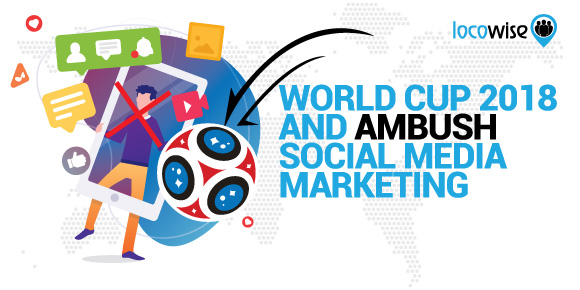World Cup 2018 And Ambush Social Media Marketing
Sahail Ashraf posted on 7 August 2018
Social media and sports are made for each other. Whenever a big event happens in the world of sport, it’s easy for a brand to tie-in. This year saw perhaps the biggest sports event of all hitting the world’s stage. The World Cup was held in Russia in 2018, and the amount of hype and excitement building up before it was huge. It just kept getting bigger and bigger. Part of the snowball effect was the participation of some huge brands. That participation was perhaps bittersweet for other brands, but more on that later.
The World Cup has often held a lot of value for brands. We take a look at some amazing work from the last tournament, and some real winners from this year too.

Coca Cola (2014 World Cup)
This brand obviously needs no introduction, but it managed to gain the biggest amount of free publicity via social media at the 2014 World Cup. It will not have escaped anyone’s attention that Coca-Cola were a major sponsor. This means that no matter where you looked during a match, you’d soon see the logo of the famous beverage company. It was instantly recognisable, and very much front and centre.
This worked a treat for the brand, who managed to be featured in a huge number of social media posts. The posts were not created by Coca Cola, but were instead created and shared by football fans. On Twitter, for example, tweets that showed action from the field invariably showed the digital billboards that are now a common fixture in every sporting event. Coca-Cola poured a lot of money into advertising, and had even more buzz generated by the simple fact that any tweet or post from the games had a strong chance of featuring a billboard.
Nike (2014 World Cup)
Back in 2014, Nike rode high off the success of the Risk Everything campaign, a group of videos that were shared repeatedly across every single social network you could think of. The campaign reached its peak with videos that covered nearly every famous world player on the pitch with ordinary people.
It was inspired and obviously cost a fortune (Ronaldo, we suspect, doesn’t work for free), and showed just how closely Nike has linked it’s work with some major sporting figures. Just for good measure, Kobe Bryant and The Hulk showed up too.
If you want to take a look at the video, you can get a chance here. It’s well worth watching, and a good example of a campaign that ties into the ethos behind a brand.
McDonalds (2018 World Cup)
McDonalds as a brand don’t mess about with big events, and they often bring their own rather unique approach. This World Cup was no different, with a real focus on the people rather than the players. The World Cup was celebrated by a very special competition.
The Shout and Share competition was visible across all of the McDonalds online real estate and provided people with the opportunity to get across just how much they loved the team they were rooting for. With a strong hashtag and a set of fun videos that really conveyed the excitement of the World Cup, as well as tapping into the fan love, it was a sure-fire bet to win.
The competition blew up on Twitter. It was a great idea, and involved the engagement factor (fans had to physically take a photo of a cup, for example) as well as the promise of a real reward for those who won. The sweepstake happened to have a rather amazing prize attached, no one would say ‘no’ to a World Cup trip.
IT’S KICK-OFF TIME for the McDonald’s Shout & Share a Coke FIFA World Cup™ Sweepstakes! You could WIN a trip to the FIFA World Cup™ to witness all the soccer action, or 1000s of other incredible prizes. Get to a McDonald’s & start playing now! pic.twitter.com/DqdavNqoSw
— McDonald's (@McDonalds) June 4, 2018
So far, so official
Now we are going to look at Umbro. This was a more exciting, and ‘niche’ kind of social media marketing. Umbro have an obvious and vested interest in the World Cup and football in general, but that didn’t stop them from producing one of the most intriguing social media tie-in sports of the tournament.
They picked a YouTuber (Brett Domino) and essentially asked him to produce a video on how to make a World Cup anthem. The whole thing was done with a bit of a cheeky flair to it, and if you watch the video carefully, you’ll soon see why it was a quirky take on the whole tournament.
We like this because Umbro are probably wary of how they could ever publicise their connection to football in any context other than straight advertising, but this one gets top marks because it is simply clever.
The Ambush Marketing Principle
However, it also leads to the big problem around social media for the World Cup. Brands were effectively forced into a situation where they either forked out incredible sums of money to be a sponsor for the FIFA tournament, or risk severe fines for ‘ambush’ marketing. Ambush marketing occurs when a brand jumps on an event and gains marketing traction without being an official partner of that event. Watch the Umbro video and you’ll see why it works so well.
The two examples from 2014 don’t illustrate that problem. Things have become very difficult for the average brand, and if we’re going to learn anything from how coverage was ‘enabled’ by FIFA this year, it’s that you can still have a brand presence during the tournament even if you aren’t an official sponsor.
Umbro didn’t do what they did because they wanted to get one over on FIFA. It’s plain to see the brand genuinely loves football, and has a place in the industry. If anything, the more groups like FIFA ringfence a tournament for the big industry players, the more smaller brands will find a way to legitimately ambush it.
Fancy a set of metrics that actually make sense? How about charts and graphs that tell the whole social media story for your brand? Try Locowise for free, for a whole week. You won’t regret it.




